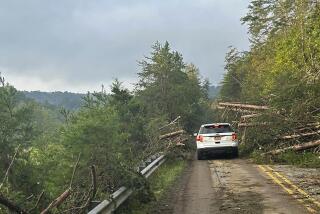Ernesto Loses Strength, but Is Blamed for Four Deaths
- Share via
WASHINGTON — Ernesto, which briefly became the season’s first hurricane last week, weakened Friday to a tropical depression as it hit Virginia and North Carolina.
The system carried 35 mph winds and dumped 6 to 12 inches of rain in parts of the two states. Hundreds of thousands of people lost power, especially in Virginia’s dense Hampton Roads region, encompassing the Norfolk and Virginia Beach areas in the state’s southeastern corner.
“Stay home. Stay dry. Stay safe,” advised a bulletin on the Hampton Roads website. Authorities urged residents to remain inside Friday because of flooding, power outages and numerous minor accidents.
The storm was blamed for at least two traffic deaths in Virginia and one in North Carolina. Another person died when a big tree fell on a modular home in Gloucester, Va., authorities said.
In Kitty Hawk, on the Outer Banks of North Carolina, code enforcer and building inspector Stephen Smith said weather conditions were “not very bad at all.”
Smith said flooding had closed parts of U.S. 158, the area’s main highway, but no trees had fallen and no homeowners or business operators had reported serious damage.
Kitty Hawk, with a year-round population of 3,500, is a resort area that swells to about 20,000 in summer.
The National Hurricane Center said in an advisory Friday that Ernesto would continue to lose force as it moves north over the weekend through Virginia and the mid-Atlantic states.
The governors of North Carolina, Virginia and West Virginia and the mayor of Washington, D.C., each declared a state of emergency because of the storm.
At Georgetown University in the nation’s capital, where the school year started Wednesday, the storm left students in a somber mood.
“It’s the most disappointed I’ve ever seen campus for a rainstorm,” said senior Aerin Miller, 20, who is from Los Angeles. “With the start of school, it’s a great time to just be outdoors in the sun, but not now.”
Maryland Gov. Robert L. Ehrlich Jr. said he chose not to enforce emergency conditions because his state had been so dry.
Gov. Ed Rendell of Pennsylvania cleared his campaign and official schedules because of the storm, and he put state police and the National Guard on alert.
At Colorado State University, veteran hurricane forecaster William Gray on Friday lowered his predictions for the 2006 Atlantic storm season, which runs June 1 through Nov. 30.
Gray said he reduced his expectations because August was relatively calm.
“We had been forecasting 17 named storms,” he said in a telephone interview. “On Aug. 3, we reduced that to 15, and we’ve now brought it down to 13. Of hurricanes, we had been forecasting seven, and we’ve dropped it to five.”
Gray, a professor emeritus of atmospheric science who has been watching storms for 45 years, said he and his team lowered the number of major storms they expect for 2006 to two. And, he said, “there’s a good possibility that we will see some good storms during the coming month.”
Typically, Gray said, September accounts for almost 50% of storm activity, with October and November claiming about 25%.
On average, the Atlantic basin sees 9.6 named storms, 5.9 hurricanes and 2.3 intense hurricanes per year. The 2005 season set a record with 28 named storms and 15 hurricanes -- including Katrina, which devastated New Orleans and the Gulf Coast when it hit last year. .
“Often, storms do more good than bad because the rain they bring is often worth more than the damage they do,” Gray said. “Now with Katrina, you can’t say that about that storm.”
moises.mendoza@latimes.com
Mehren reported from Boston and Mendoza from Washington.
More to Read
Sign up for Essential California
The most important California stories and recommendations in your inbox every morning.
You may occasionally receive promotional content from the Los Angeles Times.













